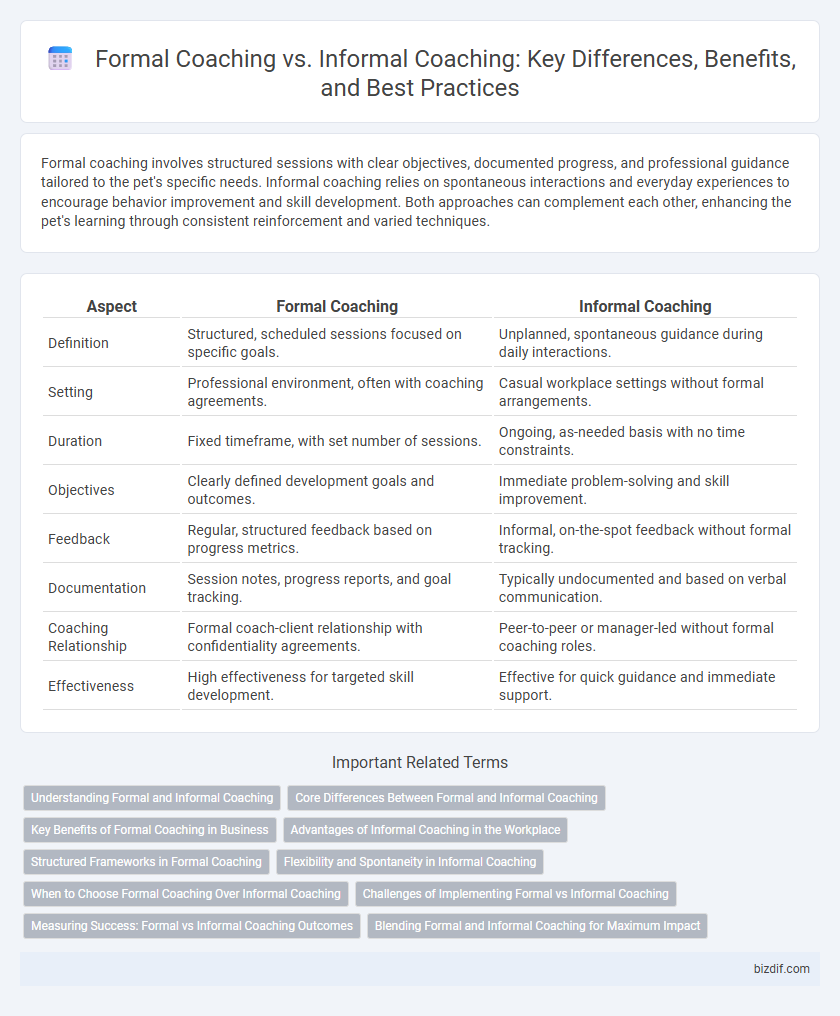Formal coaching involves structured sessions with clear objectives, documented progress, and professional guidance tailored to the pet's specific needs. Informal coaching relies on spontaneous interactions and everyday experiences to encourage behavior improvement and skill development. Both approaches can complement each other, enhancing the pet's learning through consistent reinforcement and varied techniques.
Table of Comparison
| Aspect | Formal Coaching | Informal Coaching |
|---|---|---|
| Definition | Structured, scheduled sessions focused on specific goals. | Unplanned, spontaneous guidance during daily interactions. |
| Setting | Professional environment, often with coaching agreements. | Casual workplace settings without formal arrangements. |
| Duration | Fixed timeframe, with set number of sessions. | Ongoing, as-needed basis with no time constraints. |
| Objectives | Clearly defined development goals and outcomes. | Immediate problem-solving and skill improvement. |
| Feedback | Regular, structured feedback based on progress metrics. | Informal, on-the-spot feedback without formal tracking. |
| Documentation | Session notes, progress reports, and goal tracking. | Typically undocumented and based on verbal communication. |
| Coaching Relationship | Formal coach-client relationship with confidentiality agreements. | Peer-to-peer or manager-led without formal coaching roles. |
| Effectiveness | High effectiveness for targeted skill development. | Effective for quick guidance and immediate support. |
Understanding Formal and Informal Coaching
Formal coaching involves structured sessions with clear objectives, scheduled timelines, and typically certified coaches guiding the process. Informal coaching occurs spontaneously through everyday interactions, emphasizing real-time feedback and relationship-driven development without rigid frameworks. Recognizing the differences helps organizations balance consistent skill-building with adaptive, personalized growth opportunities.
Core Differences Between Formal and Informal Coaching
Formal coaching involves structured sessions with predefined goals, schedules, and methodologies often led by certified coaches, ensuring measurable outcomes and accountability. Informal coaching occurs spontaneously through everyday interactions, relying on real-time feedback and natural opportunities for guidance without strict frameworks. The core difference lies in formal coaching's intentional planning and documentation, contrasting with informal coaching's flexibility and integration into daily work relationships.
Key Benefits of Formal Coaching in Business
Formal coaching in business offers structured goal-setting and measurable performance improvements, fostering accountability and professional growth. It provides access to certified coaches with specialized expertise, ensuring consistent development aligned with organizational objectives. Companies benefit from formal coaching by enhancing leadership skills, increasing employee engagement, and driving overall productivity.
Advantages of Informal Coaching in the Workplace
Informal coaching in the workplace fosters spontaneous learning and real-time feedback, enhancing employee skill development without the need for scheduled sessions. It encourages open communication and trust between colleagues, promoting a collaborative culture that boosts motivation and engagement. This flexible approach adapts quickly to individual needs, accelerating performance improvement and problem-solving effectiveness.
Structured Frameworks in Formal Coaching
Formal coaching employs structured frameworks, such as GROW (Goal, Reality, Options, Will) and SMART (Specific, Measurable, Achievable, Relevant, Time-bound) goal-setting models, to ensure systematic progress and measurable outcomes. These frameworks provide clear stages for assessment, feedback, and development, enhancing accountability and consistency throughout the coaching process. In contrast, informal coaching often lacks these defined structures, relying more on spontaneous dialogue and situational guidance.
Flexibility and Spontaneity in Informal Coaching
Informal coaching emphasizes flexibility and spontaneity, allowing coaches to tailor conversations based on real-time needs and employee readiness. This approach encourages natural dialogue and immediate feedback, fostering a more dynamic and responsive development process. The adaptive nature of informal coaching contrasts with the structured, pre-planned sessions typical of formal coaching frameworks.
When to Choose Formal Coaching Over Informal Coaching
Formal coaching is ideal when structured skill development, measurable progress, and accountability are essential for achieving specific professional goals. Organizations select formal coaching for leadership development, performance improvement, or career transitions to ensure consistent methods and documented outcomes. Informal coaching suits spontaneous guidance, but formal coaching provides a strategic framework that drives sustained growth and objective evaluation.
Challenges of Implementing Formal vs Informal Coaching
Implementing formal coaching faces challenges such as rigid structures, scheduled sessions, and resource allocation, which can hinder spontaneity and limit personalized support. Informal coaching struggles with lack of documentation, inconsistent feedback, and difficulty in measuring progress, leading to less accountability and unclear development paths. Both approaches require a balance to ensure effectiveness in employee growth and organizational alignment.
Measuring Success: Formal vs Informal Coaching Outcomes
Measuring success in formal coaching relies heavily on predefined metrics, such as goal achievement rates, performance evaluations, and structured feedback sessions. Informal coaching outcomes are often assessed through qualitative indicators like improved team dynamics, enhanced employee engagement, and real-time problem-solving effectiveness. Organizations that balance both approaches tend to see comprehensive development outcomes, combining measurable progress with adaptive skill enhancement.
Blending Formal and Informal Coaching for Maximum Impact
Blending formal coaching structures with informal coaching interactions creates a dynamic learning environment that enhances skill development and performance. Formal coaching provides clear objectives, measurable outcomes, and accountability, while informal coaching fosters real-time feedback, relationship building, and adaptive learning. Integrating both approaches leverages the strengths of each to maximize employee engagement and long-term growth.
Formal Coaching vs Informal Coaching Infographic

 bizdif.com
bizdif.com